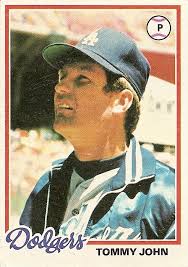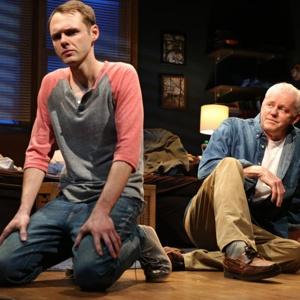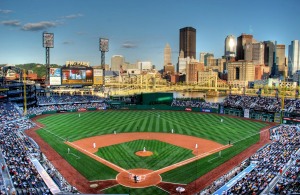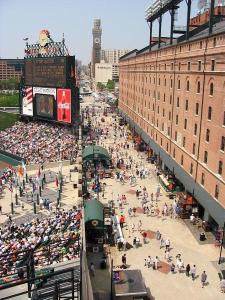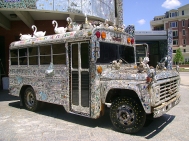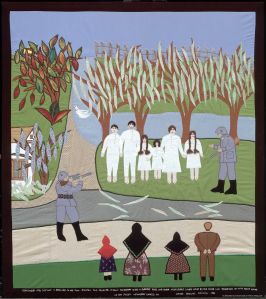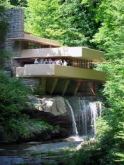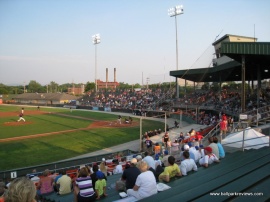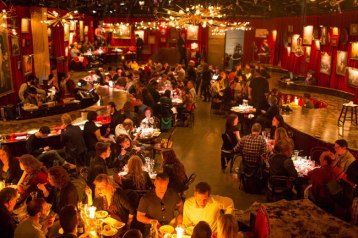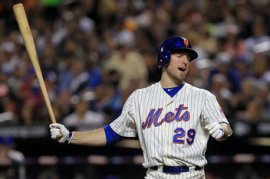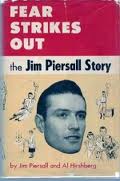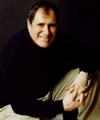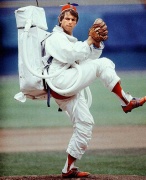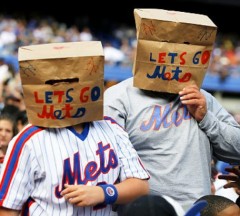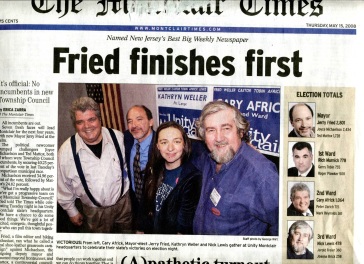 I’ve kind of fallen out of the blogosphere recently, but I’ve been planning to jot down my thoughts about the Mets this year. I’d meant to do this as a pre-season exercise, but never got around to it, so now I get to do it knowing that the Mets won’t have Bobby Parnell all season. Despite that, I do think the Mets will be incrementally better this year and, absent a disaster, they should win in the neighborhood of 80 games. But they are a lot more likely to win 70 than win 90 and, at some point, you have to actually win enough games that people take you seriously as a team, rather than just waiting for next year. You would think that GM Sandy Alderson would be feeling the pressure at this point (which may explain his “90 win goal” comment).
I’ve kind of fallen out of the blogosphere recently, but I’ve been planning to jot down my thoughts about the Mets this year. I’d meant to do this as a pre-season exercise, but never got around to it, so now I get to do it knowing that the Mets won’t have Bobby Parnell all season. Despite that, I do think the Mets will be incrementally better this year and, absent a disaster, they should win in the neighborhood of 80 games. But they are a lot more likely to win 70 than win 90 and, at some point, you have to actually win enough games that people take you seriously as a team, rather than just waiting for next year. You would think that GM Sandy Alderson would be feeling the pressure at this point (which may explain his “90 win goal” comment).
But if you are going to be mediocre, the Mets are certainly in the right division. This is definitely not a great group of teams and the Nationals should win it easily. The Phillies are old, bad and getting worse. If they start off slowly and decide sell off Cliff Lee and their good old players (and there are fewer of those than you’d think), they might really stink this year. In any event, they are headed into a serious down period that should last for years. The Mariners are the reverse sort of team. They have young talent (probably too young for this year), especially pitchers, but a miserable lineup and the Mets should beat them for third. The Braves are certainly more talented than the Mets, but they have had terrible injuries to their pitching and have big holes in their lineup. It isn’t hard imagining a big slip back toward .500, so it is possible that a mediocre Mets team could actually be fighting for second place (but not a playoff spot absent a series of miracles) at season’s end. The problem is that if you are a mediocre second or third place team, you are still just mediocre. I have to admit that I’m getting impatient and I’d like to see a meaningful September game, something that hasn’t happened in Citifield for so long that I’m not sure that there has ever been one in September at the now not-so-new ballpark.
Are the Mets broke? There has been endless speculation about this. The Mets apparently owe a lot of money to the banks and some wonder if the banks are preventing the Mets from spending. It would be an odd, counterproductive bank policy, since the Mets really need to spend some money to improve their team and more attract fans, allowing them to make more money to pay off their creditors. On the other hand, banks do lots of stupid things and often seem like they have never heard of economics. So is lack of money why didn’t the Mets make a big splash in free agency this past off season? I think another way of looking at it is that the Mets and Sandy Alderson just have different view of the market for baseball talent:
There is no question that the market has changed in a number of ways. (1) Almost all teams manipulate their prospect’s playing time and then sign the good ones to extensions, so that the really good players don’t reach free agency until their early 30s or later, when the are starting on the downslope of their careers. (2) While baseball players in the PED Era had suspiciously long careers playing at high levels, it would be fair to wonder whether contracts paying large sums for a player’s age 37-40 seasons is a smart thing if player decline is going to return to pre-PED levels. (3) The few superstar free agents command long, stupid contracts and while it is possible to plan to for some dead money at the end of one of these contracts for a great player who will put you over the top (I’m looking at your Robinson Cano), you can’t do it often (unless you are the Yankees). (4) Free agent pitchers (especially starters) get big contracts and are likely to get hurt, making contracts beyond 2-3 years incredibly risky (and making young pitchers so valuable). (5) Finally, the rules that teams like the Red Sox, Rays and As exploited in the past to accumulate draft picks, throw money at draft picks and international prospects, etc. have been eliminated. It is now more important than ever to be smart and to develop your own talent.
So if you are Sandy Alderson and you believe something like this, you probably do just what he did this off season. Even with lots of money coming off the books, the Mets avoided bidding on the superstars who would help in the short run but arguably cripple their payroll down the road. They took a chance on Curtis Granderson, whose value was depressed somewhat by two freak injuries he suffered last year and signed him to a contract that should end before his major decline occurs. The signed Bartolo Colon for two years at a relatively reasonable rate, so they can capitalize on his upside if he continues to pitch well and are not wiped out if he falls apart. They did some dumpster-diving with Chris Young and Jose Velvarde, hoping to get lucky. They continued to carefully develop their young pitching. The looked at Steven Drew and decided that $30 million and a draft choice wasn’t worth it for a shortstop who is likely to decline and would really only be worth an additional win or two, and less if Reuben Tejada remembers how to play baseball like he did in 2012. However, in light of the injury to Parnell, it is even clearer than it was at the time that the Mets should have signed a second-tier closer like Grant Balfour and otherwise upgraded their bullpen, and if you want to criticize Alderson for not spending money on free agents, that is your best argument.
Can You Ever Have Too Much Starting Pitching? There is no question that starting pitching is the strength of this team. Zach Wheeler will at least be good and might be great. Bartolo Colon was an inspired signing to replace Matt Harvey’s innings this year and is possible trade bait this summer if all of the young pitchers develop or everything collapses. Dillon Gee is a solid end-of-the-rotation innings eater that most teams would love to have. It is a little hard to say what Jonathan Niese really is (other than left-handed), but he should at least be decent. I thought that Matsuzaka was going to be the fifth starter and place-holder and was surprised (like most people) when the Mets chose Jenry Mejia, who looks like he could be very good, if his arm holds up. Dice-K (currently in AAA) will probably make an appearance when the inevitable pitcher injury happens. John Lannan would probably be in the rotation for a bad team, but he is the bullpen. Of course, in addition to all of this, the Mets have tons of pitching talent at various levels in the minor leagues. Young pitching is a pretty volatile commodity, so a good percentage of those guys will get hurt and/or burn out, but as they get closer to the major leagues, it becomes more reasonable to dream on them. Noah Syndegaard looks like the real deal as does Rafael Montero and they are in AAA with some guy named Jacob deGrom (the Mets will set a record for small d’s on uniforms if they call up him and CF Matt den Dekker to go with d’Arnaud). They could all pitch for the Mets this year. (Montero would already be pitching for many teams.) There are apparently more arms in the lower levels of the minors. And of course, next year, Matt Harvey will will return, along with Jeremy Hefner (who last year apparently had made a Faustian pact and was pitching shockingly well, when the devil showed up and took his elbow back). So the Mets have lots of starting pitching in the majors and on the way. The question is what do you do with it all? It’s one thing have Dice-K or Lannan around as insurance policies in case of injury, but young. talented guys have to pitch and, if they are ready to pitch in the majors, as it seems a number of them are or will be this year, it makes little sense to have them rotting in Las Vegas, although that does delay their paydays. They could bring up pitchers and stick them in their bullpen, which could certainly use the help, or they could make some trades to strengthen one of their many other weaknesses. Either way, the Mets have reached the point where they are going to have to make some decisions this year about who stays and who goes, and about who is a starter and who is a reliever, that will determine, not just their success this year, but in years to come. Starting pitching is valuable and young starters are like gold. If you analyze your talent correctly you can look very smart, but if you don’t you can look terrible. You can trade a young Nolan Ryan for Jim Fregosi or you can use Floyd Youmans to help you get Gary Carter or trade Neil Allen for Keith Hernandez. This is what to watch over the next year.
What about the Offense?: It was pretty pathetic last year and, despite the addition of Curtis Granderson, who really just replaces Marlon Byrd’s good production from last year, it is hard to see it being much better. The Mets problem is that seem to only develop players like Daniel Murphy or Lucas Duda. They seem like pretty good hitters, but they don’t hit well enough to play at a position like first, where you must be a very good hitter, or field well enough to play a position up the middle, where their hitting skills would look good. Imagine a guy who hits .250 with 15 home runs and draws a decent number of walks. If he is your second baseman or shortstop (and can actually field well, unlike Murphy), you are happy. If he is your first baseman, say hello to Lucas Duda. Wilmer Flores was supposed to be the answer, a hard-hitting shortstop. There is no question that he is their best hitting prospect, but as he got older, he got bigger and slower and is really the second coming of Daniel Murphy. Like Murphy, he should probably play third, but cannot on this team and has never played in the outfield. The Mets have to figure out what to do with him, because he can actually hit.
Ike vs. Duda? It’s a good back page story, but the real question is why the Mets don’t have a good first baseman. What looked like a strength when Ike Davis was hitting in the second half of 2012 has turned into a black hole. And Lucas Duda is just mediocre. Big and strong, Duda looks like he should hit but he doesn’t really, and he can’t run and he can’t field. He is barely good enough to be in the major leagues and would be a bench player, at best, for any decent team. Ike Davis teased me into thinking he might be a good player, or at least a low batting average, power hitting, good fielding first baseman, kind of like Carlos Pena. But he is too inconsistent, doesn’t drawn enough walks to support his low average and doesn’t seem to have the ability to make adjustments. Maybe Wilmer Flores should be the next first baseman, since the idea of playing him at shortstop on a team built around pitching is ludicrous. I suppose we can just pray that Ike or Duda have fluke good year. The Mets seem to value these guys more than anyone else, so we are probably stuck with at least one (or both) them for at least this year.
Will the Bullpen Ruin the Season? It would be nice if the Mets’ starters all pitch seven or eight innings every game, but that just isn’t going to happen in modern Baseball. The Mets bullpen looks like a major area of weakness. I know that bullpen construction is mostly about luck and small sample size, but Alderson has not shown any aptitude for creating luck in this area (or creating his own luck by collecting hard throwers and seeing who works out). The gamble that Parnell would recover from his neck surgery failed. Valverde does not inspire confidence. There is not much out there but relievers recovering from surgery and I’d guess they’ll probably sign a guy like Hanrahan, who might help this summer. But the real answer is going to have to come from identifying one or two of the hard throwing prospects now in the minors and stick them in the pen, at least for this year. Who knows if they will do this. I suppose their is a risk that becoming a reliever could screw them up (See Chamberlin, Joba), but it always seemed to work for Earl Weaver.
Things to Look Forward To: (1) I’ve come to really appreciate what a great, professional ballplayer David Wright is. He may not be a Hall of Fame talent, but he is close and he is just fun to watch. (2) Watching Juan Lagares play center field. He really is special. I was afraid that the Mets might actually play Eric Young Jr. (a really useful, but limited bench type) in his place, but Lagares has started well enough that it probably won’t happen. (3) The development of Zach Wheeler, Jenry Mejia, and eventually Noah Syndegaard, Rafael Montero and the other young Met pitchers. (4) A summer listening to the Mets remarkably wonderful TV announcers.
Things to worry about: (1) Any serious injury to David Wright or Granderson would be crippling and they would not recover. Without one of them, their offense would be terrible, Without both, they might never score a run. (2) The bullpen turns out to be so putrid that it drags the team down the gurgler.(3) Travis D’Arnaud turns out to be complete bust and by mid-June, he is hitting under .200. I don’t think this isn’t too likely, but the alternate, more possible nightmare is that he gets hurt. The Mets really don’t have another option at catcher. (4) The Mets have a long losing streak early in the year and decide to trade Colon, etc. to build for the future and the season spirals down to a fight to win 70. (5) They trade Ike Davis for a bag of baseballs (there is no way that they can get much for him) and he hits 35 homers somewhere.
Let’s Go Mets!
